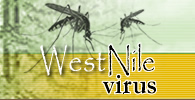Common menu bar links
Institutional links
Diseases & Conditions
Health & Safety
Research & Statistics
Agency Information
Search Box
E-mail this page
How to Protect Yourself & Your Family
West Nile virus is primarily transmitted to people through the bite of an infected mosquito. Evidence shows that many people infected with West Nile virus have mild symptoms, or no symptoms at all. People with weaker immune systems and people with chronic diseases are at greater risk for serious health effects.
Although the chance of being infected is low - and the percentage of those infected that develop severe health effects is even lower - everyone in an area that has West Nile virus activity is at risk. However, risk for serious health effects generally increases with age. It is very important to reduce the risk to you and your family by taking steps to avoid mosquito bites since this new disease is in Canada to stay. Last year, West Nile virus was identified in Quebec, Ontario, Manitoba, Saskatchewan and Alberta.
What Can I Do to Protect Myself and My Family?
The best way to avoid becoming infected with West Nile virus is to not get bitten by a mosquito. There are two ways to lessen the risk of mosquito bites for you and your family:
- Protect yourself and your family from mosquito bites; and
- Eliminate mosquito breeding sites around your home and vacation property.
By taking simple precautions to lessen your chance of being bitten by a mosquito, you can also lessen your chance of getting West Nile virus.
- Protect yourself and your family from mosquito bites:
- When going outdoors, use insect repellents that contain DEET or other approved ingredients
- Wear protective clothing such as long-sleeved shirts, long pants and a hat. Light coloured clothing is best because mosquitoes tend to be attracted to dark colours
- Make sure that door and window screens fit tightly and have no holes that may allow mosquitoes indoors
- Eliminate mosquito breeding sites around your home and vacation property:
Mosquitoes lay eggs in standing water and it takes about four days for the eggs to grow into adults that are ready to fly. Even a small amount of water, for example, in a saucer under a flower pot, is enough to act as a breeding ground. As a result, it is important to eliminate as much standing water around your property as possible by:
- Regularly (twice a week) draining standing water from items like pool covers, saucers under flower pots, recycle bins, garbage cans, etc.
- Remove old unused items from around your property (i.e., old tires) which have a tendency to collect water
- Change the water in wading pools, bird baths, pet bowls and livestock watering tanks twice a week
- Cover rain barrels with screens
- Clean out eavestroughs regularly to prevent clogs that can trap water.
- Purchase an aerator or ornamental pond. This will keep the surface water moving which will make the water inhospitable to mosquito larvae.
How about Using Pesticides?
Over-the-counter products that are designed to get rid of garden pests aren't effective for overall mosquito control. Regarding the use of other pesticides, only workers who are licensed by provincial authorities and are trained in the safe use of pesticides can carry out mosquito control programs. Decisions on whether or not to use pesticides to control the spread of West Nile virus in your community will be made by local and provincial health authorities.
As a first step, people should try to eliminate standing water on their property by, for example disposing of old tires and containers and cleaning out rain gutters. However, for wholly-contained sources of standing water on private property where draining is not a practical option, there are registered Domestic and Commercial-class mosquito larvicides available. These contain Bacillus thuringiensis israelensis (Bti), a naturally-occurring microbe that has minimal impact to health and the environment. For these products to be effective, users must follow the specific instructions on proper timing for their application. For more information, visit the Pest Management Regulatory Agency Web site. ![]()

